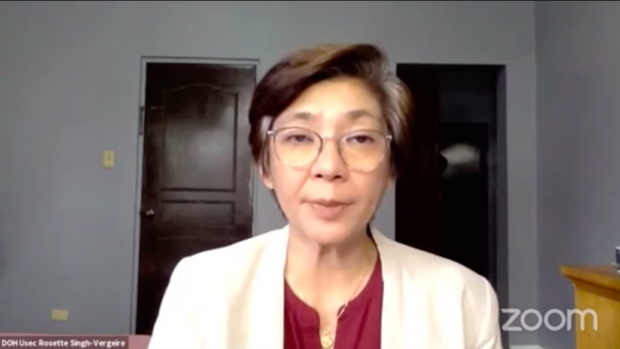
Health Undersecretary Maria Rosario Vergeire. Screengrab from DOH Facebook page
MANILA, Philippines — Although the threat posed by the new COVID-19 variant is real, the Department of Health (DOH) urges the public not to panic and to remain vigilant against the virus by strictly observing proper health and safety protocols.
There is still no indication that the highly transmissible Omicron variant is now present in the country, according to the DOH.
The reported COVID-19 positive cases involving 242 international travelers who arrived in the country in November are still subject to further testing for the Omicron variant.
The agency as of Saturday night has yet to release the genome sequencing results done on the samples from three travelers from South Africa, Burkina Faso, and Egypt who earlier tested positive for COVID-19 upon their arrival in the Philippines.
The test was done to determine if the three cases, including a 23-year-old overseas Filipino worker who flew in from Africa, had the Omicron variant.
Health Undersecretary Maria Rosario Vergeire said she believed the Omicron variant had not reached the Philippines yet. No spike, clustering
One of the indications of the possible presence of this variant would be a spike in cases and, so far, there has been no area in the country that shows a sudden increase or clustering of infections, Vergeire said.
The DOH on Saturday reported the positivity rate in the country remained at 1.8 percent and, for 22 straight days, well under the 5-percent benchmark set by the World Health Organization (WHO).
The WHO said the 5-percent positivity rate should be kept for 14 days, the maximum incubation period of the coronavirus before the spread of the virus can be said to be contained.
Case update
Health Secretary Francisco Duque III had previously said the DOH would have to wait for the WHO’s guidance before declaring that the COVID-19 transmission in the country had been contained.
In its latest report, the DOH said total cases were now at 2,834,294, with the addition of 517 new infections.
Of these, 14,338, or about 0.5 percent, were active cases. Of these, 815 were classified critical, 2,425 were severe and 911 were asymptomatic. A total of 6,350 were considered mild cases while 3,837 were classified moderate. There were 1,139 new recoveries that brought to 2,770,726 the total number of COVID-19 survivors.
The DOH said 243 fatalities brought the death toll to 49,230.
“In other countries (where Omicron was detected), cases are increasing and their numbers are suddenly spiking. We have not seen this here. So I think, as of now, this variant has not entered our country,” Vergeire said at the Laging Handa briefing.
“We see in our projections that with this type of mobility, with the level of vaccination, and with compliance to minimum health standards, cases will continue to go down up to the end of December,” she said.
Vergeire said it would be hard to say there would be an increase in COVID-19 cases in January due to the Omicron variant as predicted by independent pandemic monitor OCTA Research.
“It’s hard to give this kind of warning that could scare the people. We have no evidence yet. We are still waiting for what experts across the globe and the [World Health Organization] will release regarding the characteristics of this variant,” she said.
People have to be cautious, but there is no need to panic or to be afraid, Vergeire said. “They just need to follow safety protocols.”
In relation to the 242 travelers who, according to the Philippine Genome Center (PGC), were found positive for COVID-19, PGC executive director Cynthia Saloma said the DOH had already asked airport laboratories that tested them for samples for possible genome sequencing.
According to Saloma, the samples have to meet certain requirements before they could be subjected to genome sequencing. The PCG has the capability and sufficient kits to subject these to whole genome sequencing, she said. It can process 750 to 1,500 samples a week, but it can process 48 samples overnight if there is an urgent need, Saloma added.
Cebu City monitoring
In Cebu City, health officials are monitoring at least 120 persons in Central Visayas who entered the country before the government tightened border restrictions to prevent the entry into the country of the Omicron variant.
Dr. Mary Jean Loreche, spokesperson for the Visayas Vaccination Operations Center, said among those being monitored were Filipinos from overseas who arrived in the country through Ninoy Aquino International Airport from Nov. 15 to Nov. 30. The 120 persons under monitoring came from Austria, Belgium, Italy, the Netherlands, South Africa, and Switzerland.

